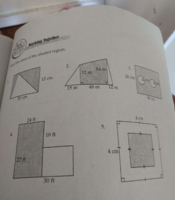onesun0000
Junior Member
- Joined
- Dec 18, 2018
- Messages
- 83
The shaded region is a quadrilateral with 4 equal sides (as shown by the double dashes). It's not obvious to me that it's a square. It's even less obvious that "its diagonal is half the measure of the diagonal of the entire figure". Please post the image of the entire problem.I am not sure whether my answer is correct. I just assumed that the shaded region is a square and its diagonal is half the measure of the diagonal of the entire figure. my answer is 8cm.
View attachment 18051
that's it. It's all that's given. I also thought the problem has insufficient given.The shaded region is a quadrilateral with 4 equal sides (as shown by the double dashes). It's not obvious to me that it's a square. It's even less obvious that "its diagonal is half the measure of the diagonal of the entire figure". Please post the image of the entire problem.
Your subject line is "Find the area of the shaded region"I am not sure whether my answer is correct. I just assumed that the shaded region is a square and its diagonal is half the measure of the diagonal of the entire figure. my answer is 8cm.
View attachment 18051
Can you please tell us the EXACT problem statement as it was given to you?that's it. It's all that's given. I also thought the problem has insufficient given.
sorry. 8 sq. cm. But that's just an answer based on assumptions, which is incorrect because what I assumed is not stated. Here's the whole page of the worksheet:Can you please tell us the EXACT problem statement as it was given to you?
Is it one problem from - a set of problems, where other information may have been given at the beginning?

Assuming, your assumption (of 1/2 diagonal) is correct, then;sorry. 8 sq. cm. But that's just an answer based on assumptions, which is incorrect because what I assumed is not stated. Here's the whole page of the worksheet:
View attachment 18052
Can you solve the other problems? They make much more sense than #5. #4 is not very clear, but it seems we have enough information.sorry. 8 sq. cm. But that's just an answer based on assumptions, which is incorrect because what I assumed is not stated. Here's the whole page of the worksheet:
View attachment 18052
Yes. I can solve for them. It's just no. 5. And there's one more that bothers me. I don't know the figure on no. 7 has enough information. This is the same book where the latter question is from.Can you solve the other problems? They make much more sense than #5. #4 is not very clear, but it seems we have enough information.

If we assume that the 2 arrow point angles are 90 degrees, we can calculate the total area.Yes. I can solve for them. It's just no. 5. And there's one more that bothers me. I don't know the figure on no. 7 has enough information. This is the same book where the latter question is from.
View attachment 18055
